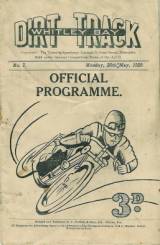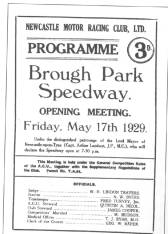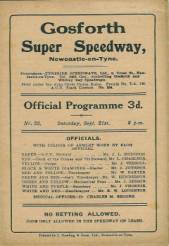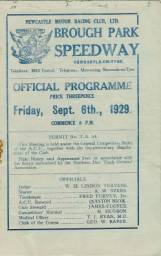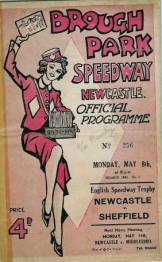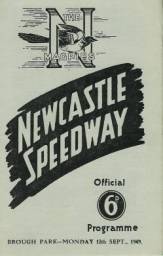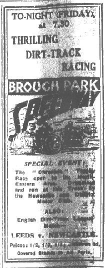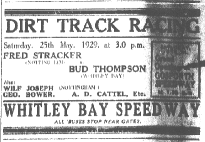


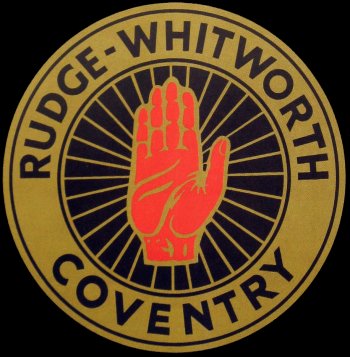

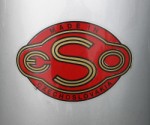

The History
Of
Dirt Track Racing
The Origins Of The
Sport
USA Or
Australia?
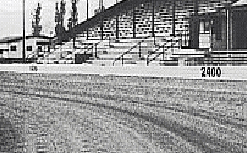
Above: West Maitland Showground track and below: Maitland's Commemorative Plaque
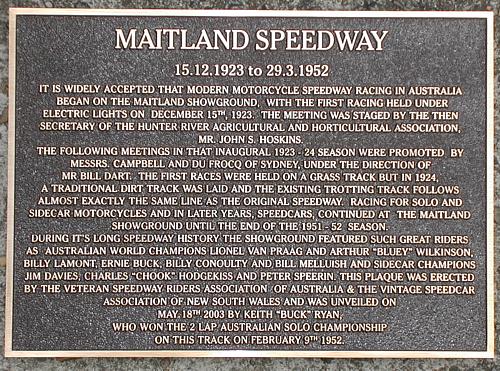
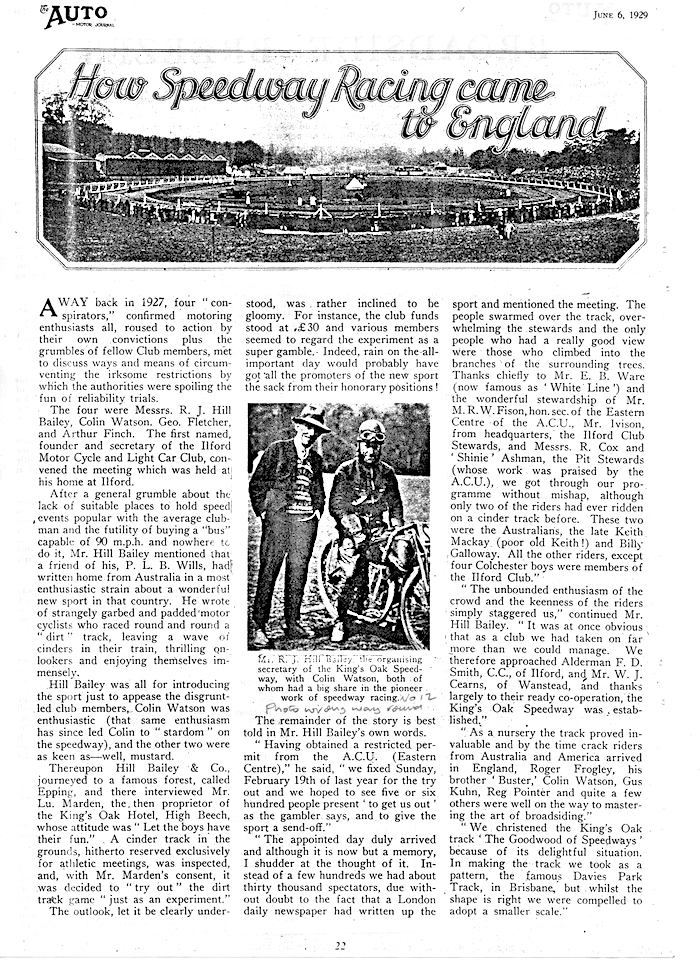
By Jeffrey Stafford.
Speedway racing is a sport with an extraordinary history. According to
Tom Stenner, speedway correspondent of the London Daily Mail, the first
speedway meeting on a dirt track was held at Pietermaritzburg, in South
Africa, in 1907. But it can be shown beyond a question of doubt that the
United States should be recognized as the birth place of motor cycle
racing. One of the principal features of the Butte Athletic Associations
meet in July 1901, were
motor cycle tandem races featuring Clem and Charles Turville, Gust
Lawson, and John Chapman. The track was constructed of board and
designed on the saucer principle by Captain T.O. Angel who had
successfully used the same design on cycle tracks in Salt Lake and Los
Angeles.
At Indianapolis, on Saturday August 14 1909, two accidents, one of them
serious, marred the national motor cycle races. In the team mile
professional race, which Jake de Pozier, of Springfield, Mass, was going
at a terrific speed, the front tyre of his motor cycle tore off,
throwing him heavily to the ground. His injuries were not fatal and he
recovered later.
Nevertheless, there can be little doubt that the evolution of Speedway
as we know it today took place in Australia. The sport of motor cycle
racing that had been popularized in America during the early part of the
nineteenth century featured a considerably variety of variations - which
were subsequently improved and standardized by a number of Australian
promoter’s to give us what is probably the most exciting of all
automotive sports.
A dirt track meeting was held on Saturday, October 11 1913, under the
auspices of the Victorian Motor Cycle Club. The meeting was marred by
the death of Harold M'Coll who collided with a fence and was killed
instantly. Another rider, A.W.Maplestone had one of his shoulders
dislocated. Twenty seven riders competed in six events. As far as I can
ascertain Harold M'Coll was the first victim of a Speedway race in
Australia.
Nine out of ten speedway historians credit Maitland showground in New
South Wales as being the birth place of speedway racing. However, the
first Speedway event, the one that perhaps marks the beginning of
Speedway proper, predates the Maitland event by eight years.
Here is an extract taken from the Saturday Referee, 6 February
1915:
Big Easter Carnival, which should provide motor cycling enthusiasts with
some fine sport. The events ; 100 miles open state Championship; 600
c.c. State Championship 66 miles ; open handicap 33 miles; and the club
handicap 33 miles. The meeting will take place at Gouldburn on Easter
Saturday, 3 April, 1915. Nor was the meeting just a one off event, there
was a very large attendance for the second motor cycling meeting at
Gouldburn held on Easter Saturday, 22 April, 1916. The big event of the
1916 Easter meeting was for machines of all powers, over 100 miles. Of
the twelve motor cycles which started, six were Indians, four
Excelsior’s, and two Harley Davidsons. L. Frank, astride a 7 h.p. Harley
Davidson, proved victorious covering the 100 miles in 2 h 8 min 55 sec.
The Sale Easter Carnival, held on Saturday, 19 March, 1921, represented
the greatest attempt that had then been made in Australia to put motor
cycling on a solid footing. The choice of Sale as the site for the
meeting was made for a variety of reasons.
When the sport began many difficulties were placed in the way of those
promoting it. In and about the Metropolitan area of Melbourne and the
outlying areas the civic authorities refused to allow motor and motor
cycling on roads and the owners of the racecourses refused to allow them
to be used for motor cycle racing.
Sale offered sanctuary to motor cycle enthusiasts. Its racecourse and
roads were offered, and the support that was forthcoming made the choice
easy. The Sale authorities not only recognized the sport, but officially
invited the Victoria Motor Club to hold its carnival in the town. For
motor cycle racing the only rival was the motordrome at the amateur
Sports ground, which in 1921 was not in site of completion. One of the
main features of the Sale Easter Carnival was the appearance of two
motor cycles that had been built entirely in Australia.
There was never a more successful motor cyclist in Australia than
Charles "Daredevil" Disney of Melbourne, known throughout Australia as
the most fearless motor cycle rider, he was able to win contest after
contest without losing what is commonly termed as "nerve control."
He was the son of one of the Ministers in the 1924 Labour Government in
Victoria. He started his riding career in 1915, by winning a seven mile
road race gaining first and fastest time.
He started life as a furniture maker, but when his brother returned from
the war they became partners in a motor cycle business. As a member of
the South Yarra Cycling Club, he achieved varied success over distances
ranging from 10 to 20 miles.
From the start of his career Daredevil Disney only utilized Indian motor
cycles due to the speed and reliability for which the machines were
famous. He knew no fear. He was often accused of being a reckless rider,
but he never injured anyone or put anyone's life in danger.
He won his first motor cycle race in 1919 - a five mile side car event.
In the same year at the Sale Easter Carnival he established himself as
one of Australia's best motor cycle riders by winning in the fastest
time the Blue Ribbon event for the road over 200 miles. Then came the
Hopkins Cup open race, and after that success on the Aspendale track,
reliability trials and jumping records. He held the Australian long
distance jumping motor cycle record, covering a distance of 54ft 6in in
the leap. He became well known on the speed track as the "Wizard of the
Track," and "Daredevil Disney."
In March 1922, he lowered the Adelaide to Melbourne motor cycle solo
record on an "Indian" Scout, by registering 16 hours and 14 minutes,
breaking the recent record set by Jack Quigley.
On Saturday February 21, 1925, he sustained an injury to his knee while
taking part in a preliminary run at the Geelong racecourse, prior to
racing against the American Paul Anderson. He was hospitalized for some
weeks at Geelong before surgeons give up hope of saving his leg. Disney
in the end resigned himself philosophically to losing his left leg to
save his life. But that did not dismay him, after leaving hospital he
entered cycle races with an artificial limb strapped to the foot rest.
Charles "Daredevil" Disney" died on 5 July 1954, aged 77. He was
cremated and his remains were scattered at the Springfield Botanical
Cemetery, Melbourne.
In 1922, John S. Hoskins, later known as the prince of speedway
promoters, was appointed Secretary of the West Maitland Agricultural
Society. At this time the organization was in a bad way. Its membership
over the years had plummeted to about 300.
Hoskins tried all manner of attractions - boxing, rodeos, and cycling -
but nothing seemed to grasp the attention of the public. Being a motor
cycle rider himself, with a number of riders, he approached the
committee of the Agricultural Society to ask permission to run a number
of motor cycle trials.
The members thought it was pure madness, and told Hoskins he was taking
a short cut to death. No amount of persuasion could convince them that
it would prove to be a success and a good investment. Eventually,
however, Hoskins got his own way and with a rider named Billy Crampton,
who was the only one with an actual racing machine in N. S. W., a
Norton, he was allowed to give his idea a try out.
One member of the committee, who was actually taken with Hogkins idea,
watched over the fence when Hoskins and Crampton were speeding around
the track, and later it was mainly through his imput that Speedway
eventually opened at Maitland. Construction of the speedway track at
Maitland commenced in October 1923, and the first Maitland Speedway
meeting was held on Saturday, November 1, 1924, for a double bill of
motor cycle and push bike racing. It was not a success. The push bikes
showed up the speed failings of the powered bikes they even recorded
better times. The track was very small, and of grass. Under half a mile
in circumference and thirty feet broad.
There was much hype for the official opening of the first Maitland
Speedway meeting held on Saturday, October 17, 1925, when L. B. Meville,
mounted on an h.p. Harley Davidson, succeeded in winning the £100 Motor
Cycle Handicap. A princely sum in 1925. The attendance was estimated at
around 1300, and the number of riders in the motor cycle handicap was a
record, 77 starting. Since the close of 1924 the track had been
considerably reconstructed. Instead of two straight and four bad turns
where many falls had occurred in 1924, the track was oval with a
straight run in front of the main grandstand. The track had also been
widened from 30ft to 45ft, the banks at both ends had been made very
much higher, and a slight smaller embankment had been built all-round
the half mile track. There were 28 races -- 23 for motor cycles and five
for push bikes.
Apart from the normal speedway meetings at Maitland, Speedway Carnivals
were held throughout the year to raise money for local charities. A
speedway meeting was held at the Maitland Speedway Carnival on Saturday,
21 February, 1925. In the final of the Championship race, a serious
accident occurred. George Kirkwood hit a fence, and another rider E.
Buck crashed into him. Buck escaped injury, but Kirkwood sustained a
compound fracture of the right leg, which was later amputated. He also
sustained many injuries to his head and body.
As a consequence of the terrible injuries received by Kirkwood a
safety rail, similar to the one at Speedway Royal was erected.
George Kirkwood was 18 at the time of his accident at Maitland; he was
born on 22 April, 1907. He passed away in NSW on 2 March, 1991, the
month before his 84th birthday.
A letter from Mr. E. B. Harkness, Under Secretary to the Chief Secretary
of NSW to the management of the Hunter River Agricultural and
Horticultural Association, criticizing the condition of Maitland
Speedway track, was published in the Maitland Daily Mercury, 15 May,
1925. The following is a short extract from the letter:-
There can now be little doubt that the case for the start of dirt track
racing at Maitland in 1923 cannot be maintained, and that dirt track
racing on the Maitland track did not commence until 1924.
In 1924 a number of Speedway enthusiast held a number of private races
on the Brisbane paddock. In the course of time the grass surface became
worn, but the process was so gradual that the change from grass to dirt
was scarcely noticed. Then, when the riders learned to slide the corners
on the dirt surface speedway racing became more spectacular. In 1925 -
two brothers, A.J. and Frank Hunting, saw the possibilities in dirt
track racing, and engaged the paddock riders from Brisbane to appear at
the Exhibition Grounds, on Saturday, 16 October, 1926. Brisbane. The
five riders were Vic Huxley, Frank Authur, Frank Pearce, Dick Smythe and
Charlie Spinks.
Speaking of the above, the following extract is taken from a letter
written by A. J. Hunter, and published in "The Referee," 23 December
1937. His reminiscences of the early days of dirt track racing are
interesting.
He states categorically that the first grass track speedway was at West
Maitland, but the first genuine dirt track for speedway was laid down
and constructed by him at Davies Park, Brisbane in 1927 -- this track
brought out the rider’s ability and daring.
When the track in Brisbane was nearly completed Hunter advertised the
opening of the meeting although he still didn't have any riders. All the
well-known motor cycle riders were skeptical, not one appeared willing
enough to give Hunter's dirt track riding idea a try. In despair, Hunter
took his idea to the Brisbane Motor Cycling Club and asked for volunteer
riders. A young man stepped forward called Frank Pearce, and told Hunter
he was willing to give it a go. Charles Spinks, then a bricklayer, was
the next to volunteer, and after him Vic Huxley. Nine other riders soon
followed -- but then the supply of volunteers dried up. All the riders
put in an appearance at the opening of the Exhibition Grounds Brisbane,
on Saturday 16 October, 1926.
The visit of the American rider Cecil Brown, a fist class rider on any
surface, raised the standard in Australia considerably. He arrived in
Australia with a reputation as a great dirt track rider, but at Penrith
he was repeatedly beaten by Gus Clifton and Billy Conoulty. However he
soon mastered the tracks and developed into one of the best riders in
Australia.
The public began to flock to Speedway meetings and new tracks began to
spring up everywhere. A track opened at Cessnock, and a year later
Newcastle followed suit. The first concrete track in New South Wales at
Maroubra was opened on Saturday, 5 December, 1925. Much interest was
taken in the Golden Helmet race with a prize of £30 and £10 per week
until the winner was defeated at a subsequent meeting. Cecil Brown was
crowned with the Golden Helmet and carried off the track shoulder high.
He won the Golden Helmet for the fifth time at the Olympia Speedway
track on Friday 2 April, 1926. His fastest lap was 93 m.p.h.
It could be argued that the very first speedway meeting took place in
New Zealand on 22 October 1923, at the Canterbury Racecourse,
Christchurch. The competition included the leading riders from all parts
of New Zealand. The races were run on a grass track, and very fast times
were recorded. The most successful rider was the well-known New Zealand
champion Percy Coleman, who made excellent time in winning the all
Powers Championship of 12 miles on his Harley Davidson.
On 9 March, 1929, dirt track racing was commenced at the Kibirnie
Stadium, Wellington.
Many speedway historians have written about the history of the sport in
England. Nine out of ten credit High Beech in Essex as the birth place
of English Speedway. But there can be no getting away from the fact that
the Moorside dirt track at Droylsden predates the High Beech track by
eight months. Many youngsters in the North West got their first taste of
dirt track racing at Droylsden, it also paved the way for other dirt
tracks in the in the Manchester area like Audenshaw, Stalybridge, New
Mills ,Salford Albion, White
City and Belle Vue. According to the Australian speedway promoter
A.J.Hunting (Sydney Referee Dec 23 1937), he helped lay down the track
at High Beech. Mr. Hill Bailey, then secretary of the Ilford Motor Cycle
Club, introduced Hunting to Mr. W.S.Cearns who asked Hunting if he would
lay down a proper track. The famous Australian Speedway promoter agreed
and assisted with the construction of the track. Two other Australians,
Keith McKay and Billy Galloway, helped to organize and participate in
the High Beech meeting.
Droylsden, unlike High Beech, was an entirely local venture without any
assistance from outside sources. The meeting was organized by the South
Manchester Motor Club and local motor cycle dealer Fred Fearnley, on
land owned by George Dodd, a farmer from nearby Ashton Moss. The event
was given a license by the ACU for track racing, and the meeting went
off as planned on 25 July 1927. There is absolutely no doubt that the
Droylesden meeting was the pioneer of Dirt track racing in England. The
ground where the event took place should be recognized by Tameside
Council as a site of historical importance
Blue Plaque commemorating the site as the birthplace of speedway racing
in the UK.
The plaque should be positioned as close to the original site of the
track as possible. If you agree, please take the time to write to:-
Arts and Events,
Tameside
MBC
Dukinfield Town
Hall,
King Street, Dukinfield
UK Dirt Track Racing
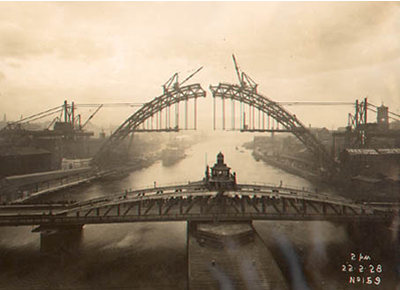
The iconic Tyne Bridge under construction in 1928. It was only a few months old when speedway started in the Tyneside region. Newcastle's link with Sydney Australia, the Tyne Bridge
Dirt Track Racing
On Tyneside
1929 Article

